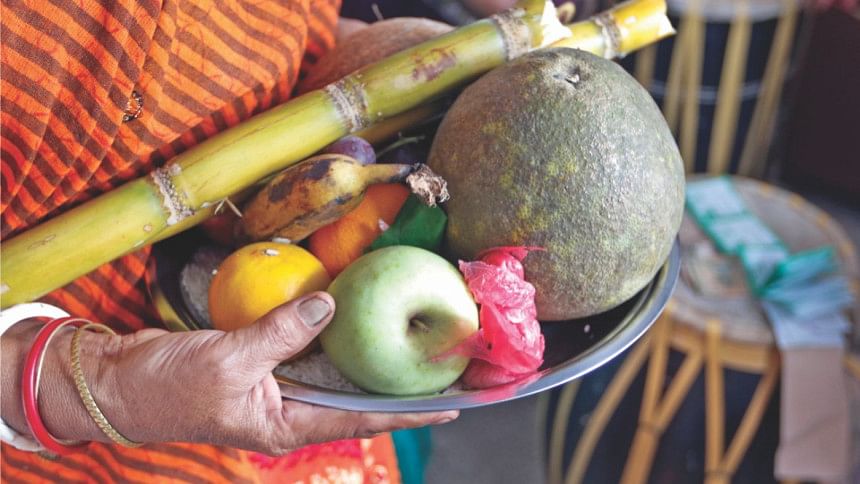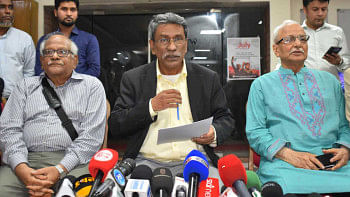Medhashmunir Ashram - A Sacred Haven

PHOTOS: PRABIR DAS
Medhashmunir Ashram, in Boalkhali, will not offer you innovative themed mandaps – all decked up with series of LED lights and the other usual puja extravaganzas. However, it is unique for the age-old history that it owns; it is unique because it allows visitors the scope to find inner peace in a place that is surrounded by natural beauty and tucked away from intrusive industrial development.
Most importantly, the Hindus in Bangladesh revere this place because of the legend that claims the area to be the origin of Bashanti Puja, the celebration of Durga Puja during spring.
"The legend in Kalika Puran and Kamakhkha Puran states that back in the age of truth (Satya Yuga), King Surath performed the first ever Durga Puja in spring after getting instructions from Sage Medha," says Professor Satchidanda Roy Chowdhury, President of the Ashram Committee.
King Surath, after being defeated and losing his kingdom, decided to leave everything behind and went to the deep forest where he met Samadhi Vaishya who also took solace in the same forest after being ousted and betrayed by his family. As they were wandering in the forest, they met Medha Muni, a sage meditating there. They went to him and asked him for the reasons behind their sufferings.

"Mahamaya (the illusion)," came the answer from Medha Muni, who also suggested that if they could get rid of this illusion and satisfy Ma Durga, the deity they would get Mahamukti and their sufferings would come to an end.
Sitting in that very forest with two very confused souls, Medha Muni gave a series of advice, known as Sri Sri Chondi. On his suggestion, King Surath and Samadhi Vaishya performed the Bashanti Puja and got back peace in their life. This launched the ritual of performing Bashanti Puja in spring or Chaitra.
"Lord Rama is believed to have performed 'Akalbodhan' ('Akal' meaning untimely and 'Bodhan' meaning awakening) to seek Goddess Durga's blessings for defeating Ravana," says Chowdhury. "Since then, Lord Rama's devotees started celebrating Durga Puja in Sharat or autumn. As a result, Bashanti Puja almost disappeared into oblivion, but it is still performed in a few Bengali households while observing all the rituals of Durga Puja."
The difference between the two Durga Pujas - Bashanti Puja and Sharadiya Durga Puja - lies in their origin story and time of celebration; the rituals remain almost the same.
During late 1900, Srimat Vedananda Swami, after years and years of meditation, received the spiritual message that on top of the Karaldenga Hills in the forest, Medha Muni meditated and suggested king Surath to offer a puja for Ma Durga for the very first time. After the rediscovery of the ashram, Medhashmunir Ashram is considered to be one of the most important pilgrimage sites for devotees.

However, the Ashram was once again demolished when during the Liberation War in 1971, the Pakistani military turned the entire place into piles of ashes and destroyed the six-feet tall deity. Right after Bangladesh's independence, there was no one to take care of this sacred ashram. With time and dedication of a newly formed Ashram committee, consisting of devotees, sadhus and pandits of the city, the ashram has once again regained its past grandeur.
"From Boalkhali till the temple, the roads are not quite commutable. The narrow bumpy roads along with the hairpin turns make it difficult for devotees to come here," says Narayan Chowdhury, a devotee who has come to the Ashram with his 90-year old sister.
But nothing really keeps one away from enjoying the serenity and natural beauty that this place offers, he adds. Once you climb the stairs, you will find a different universe up there. As soon as you get into the Ashram's territory of 69 acres, you will suddenly discover yourself surrounded by nature - by trees and flowers, by birds and reptiles, by hills and meadows.
Up there everything is silent, except for the chirping of birds and reptiles revving up in their homes, along with devotional chants and tinkling sounds of the brass bells used during Puja. While climbing the stairs, all you can see is a riot of greenery, the pinwheel patterned night-flowering jasmines, or as we lovingly call it Shiuly on, beneath your feet, signalling the arrival of Durga Puja.
This area is also home to around 30,0000 trees, including mahogany, rain tree, bamboo, mango and many more, that the Ashram people have nurtured in the last 18 years. They also cultivate honey and use it for different rituals in the temples. "For this huge plantation scheme, the ashram recently received a tree plantation award from the Bangladesh government," informs Mithu, who takes care of this place.
Upon arriving at the peak, you will find a total of seven temples, standing tall. While you will find some devotees sitting in a corner humming kirtans and preparing to feed the devotees (annaprasad), others will be busy making garlands and helping the Maharaja of the temple to prepare for the Puja. In the back courtyard, you will find people tying knots on trees, while some might be feeding a group of turtles. In fact, it will take a whole day to walk around the whole area.

"During the time of Ashtami this year, around 1,500 devotees gathered here. As this place is the origin of Bashanti Puja, it attracts the most number of devotees every year. Last year, we had almost 11000 devotees present here," informs Bulbulanda, the Maharaja of the ashram.
Despite being such a significant religious place, the lack of funds remains one of the main challenges here. According to the Shebayets (people who take care of everything of a temple), maintaining such a huge plantation requires substantial amount of manpower that they lack here. Moreover, wire-fencing and boundary walls, along with night guards are needed for the safety of this sanctuary.
A devotee and Ashram committee member, who wants to remain anonymous, informs that the government allotted money to develop roads there a few times, but even 50 percent of that money could not been spent on the express purposed because of corruption of local MPs.
"At present, we have around 85,000 devotees visiting the Ashram every year, but if proper roads are built and if the place receives proper publicity, this number could accelerate to 5 lakh," believes Bulbulanda.
"The temple is mostly run by the funds given by devotees. Previously, there were no stairways and climbing the temples was an arduous task," says Maharaja. "You see these tiles-fitted, 11 feet wide stairs? One of the devotees constructed this. Most of the temples here, Nat Mandir, Kamakhya Mandir, Sib Mandir are the result of the generosity and belief of the devotees."
"We don't want to turn the Ashram into another commercial tourist spot, as it will hamper the peaceful ambience and the spirituality here. But if this place could be promoted as one of the significant areas of religious tourism in Bangladesh, devotees from neighbouring countries could also visit this ashram," concludes Maharaj.

 For all latest news, follow The Daily Star's Google News channel.
For all latest news, follow The Daily Star's Google News channel. 



Comments